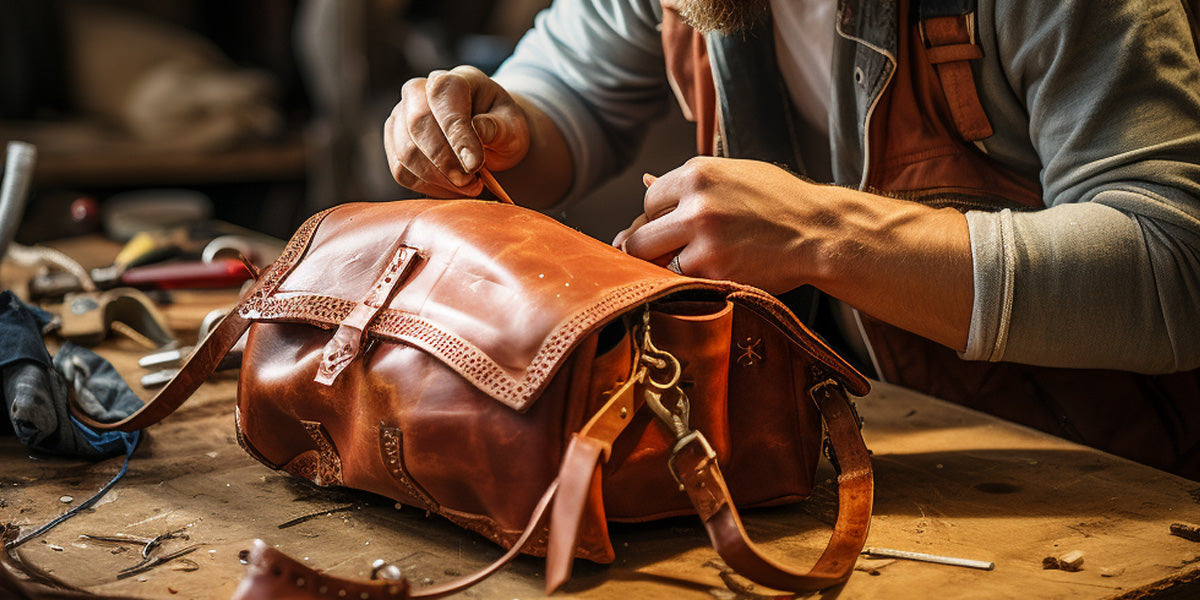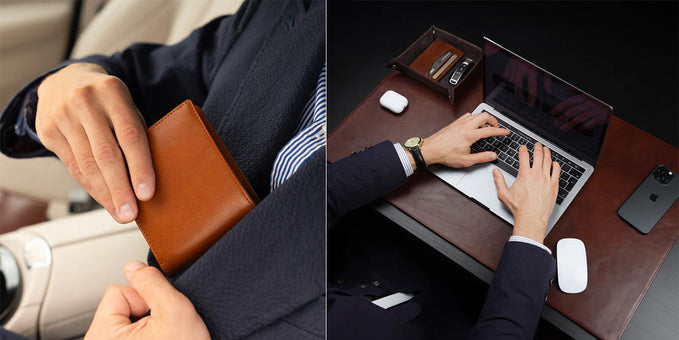How To Repair Leather Cracks, Tears & Holes

Leather products aren't cheap, so if you've damaged yours, then you'll want to get repairing it asap.
But it's important you don't do it wrong.
In this guide, we'll walk you through how to repair your leather item properly.
Tools and Materials You Need
Here's what you need to repair your leather item:
- White vinegar or a leather cleaner
- Glue applicator (that could be a needle, toothpick, or similarly sharp object easily disposable)
- Masking tape
- Bowl
- Pincers
- Denim patch
- Glue for leather
- Two rags for cleaning clothes
- Sandpaper that’s fine-grit (non-compulsory)
- Leather colorant (non-compulsory)
- A pair of scissors
- A leather repair kit (non-compulsory)
- A leather sealant (non-compulsory)
You can purchase high-value leather working tools here.
1. Evaluate the Damage
- It is critical to analyze the damage before beginning repairs.
- Scratches and scuffs on the leather are surface damage that can be fixed with a leather repair kit.
- If there is a hole or torn leather, a patch is required for repair.
2. Ensure the Area Is Clean

- Clean the surroundings to remove dirt and filth before starting the repair.
- You can use a cleaning solution designed for leather sofas or create a homemade solution using equal parts warm water and white vinegar.
- Gently dip a clean rag into the cleaning solution and wipe away any dust or dirt with circular motions around the tear.
- Avoid saturating the leather to make the repair process easier.
- Use another cloth to dry the area properly to prevent the solution from soaking into the leather.
3. Remove Any Stray Threads
- Trim any loose threads or fragments of string on the edges of the tear with scissors.
- Ensure the edges are uniform and smooth to create a strong bond with the glue in the next phases.
4. Cut and Apply a Substrate Patch
- Cut a denim patch into a square shape with rounded edges using scissors.
- The patch should be bigger than the tear to thoroughly fill the hole.
- Insert the patch into the tear and adjust it with tweezers to ensure it sits nicely beneath the leather's surface.
- Avoid creating ridges or lumps; the patch should cover the entire area behind the tear.
5. Apply Glue for Leather

- Lift the tear's side and add a leather glue drop to the applicator's tip.
- Apply a uniform coat of glue to the area under the tear.
- Apply the adhesive to both tear edges and wipe away any excess glue with a dry cloth.
6. Secure Your Seam and Allow It to Set
- Pinch the tear's two sides together to create an even line and smooth away any ridges or lumps for a flat surface.
- If needed, reattach the two sides and remove any extra adhesive.
- Maintain mild pressure on the seam for approximately five minutes to allow the glue to set.
- If the tear opens again, add more adhesive and reattach the seams, giving it five more minutes to set.
- Allow the glue to set for one to two hours after securing the tear's seam with masking tape.
7. Final Touches (Non-Compulsory)
- For scratches or scuffs on the leather, use a leather repair kit.
- Remove any stray fibers and ensure the area is clean.
- Apply leather binding glue to the affected part.
- Sand the surface using fine-grit sandpaper and remove any remnants.
- Fill scrapes, holes, and gouges with leather putty using a leather repair kit.
- Sand the area again and remove any leftover putty.
- Apply several layers of leather colorant.
- Finish the process with a leather sealant to lock in the color.
Looking for a New Leather Bag...Check Out Von Baer
If you understand leather, you know that full grain leather is the best you can buy.
And guess what?
Von Baer only use full grain leather in their bags, handmade in Italy by master craftsmen.
Browse the range now, at vonbaer.com.
FAQs
Is it possible to repair a synthetic leather sofa that’s ripped?
You can repair a ripped leather sofa by following the steps in our guide above.
Are cat scratches on leather furniture impossible to fix?
Cat scratches can be fixed, if you recolor the material using leather balm.
That’s a quick way to fix it without repairing the roughness.
If the roughness bothers you, follow the steps for sanding above.
Hiring a Professional vs. Repairing Yourself
Repairing a ripped sofa will set you back between $0 and $20. Most supplies and equipment required for the project are items you typically find in your home, so your only expenses will be the denim patch and leather glue, both of which are available for as little as $20 or less.
Hiring a professional should be your next move if you have a large tear or have exhausted all DIY options. Most leather furniture repairs are in the $100 to $400 range. You can expect to pay between $100 to $150 for a single stain on your sofa.
Remember that patience and a keen eye for detail are essential for a successful repair.
Take it easy; don’t rush. If you follow the instructions, your leather product will appear almost new.
Conclusion
We hope you enjoyed our article on how to repair leather.
If you have any questions or comments, contact us at info@vonbaer.com, or leave them in the comments.
Want to read more? Check out our Leather pages.
Related articles:
- Repair cat scratches on leather
- Remove water stains from leather
- Remove ink from leather
- Get smell out of leather
- Remove stains from leather shoes
- How to reform a leather bag
- How to maintain leather bags
- Repair cracked leather
- How to restore faded leather bag
- How to stretch leather
- How to shrink leather
- How to soften leather
- How to wash leather
- How To Fix Scuffed Leather
- How To Rehydrate Leather
- How To Stiffen Leather
- How To Restore Leather
- How To Dye Leather
- How To Get Wrinkles Out Of Leather
- Wet Molding Leather

Author: Albert Varkki
Albert Varkki is the co-founder of Von Baer. He understands leather products as a consumer, supplier, and a manufacturer, helping you with the inside knowledge you need, to choose the perfect leather product for you.
We strive for the highest editorial standards, and to only publish accurate information on our website.
Leave a Comment
Your email address will not be published.







